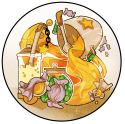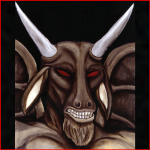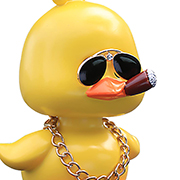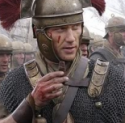|
Generally speaking thatís a Navajo rug, I canít speak to the name of the specific pattern. It doesnít look very traditional - the style has become fashionable over the past couple of decades so there are lots of derivatives at this point.
|
|
|
|

|
| # ? Apr 18, 2024 06:01 |
|
kedo posted:Generally speaking thatís a Navajo rug, I canít speak to the name of the specific pattern. It doesnít look very traditional - the style has become fashionable over the past couple of decades so there are lots of derivatives at this point. Fayez Butts posted:Native American, to be absurdly broad Thanks dudes. Additional research has shown that's it's likely from the late '80s/early '90s, which makes sense given the bundle of other rugs that came with it.
|
|
|
|
I've been buying domains lately that I think are funny and figure I should come up with websites to go with them. I've looked into some WYSIWYG/Hosting all-in-one type solutions and they seem fine. I've also got some, I'm sure, very dated experience with HTML but also have some free time and a DYI streak. Was wondering if some of you friends might give me some advice on places to start with basic web design. Or, if that's too much of a can of worms for too little return... A recommendation for your preferred website builder. Thanks George Sex - REAL fucked around with this message at 23:38 on Mar 4, 2020 |
|
|
|
Wordpress is alright if you just want a minimum-effort website, though it has a habit of not letting you easily adjust the bits you want to. It has a billion plugins, really easy to set up comments, a shop, that sorta jazz.
|
|
|
|
|
Dorkopotamis posted:I've been buying domains lately that I think are funny and figure I should come up with websites to go with them. I've looked into some WYSIWYG/Hosting all-in-one type solutions and they seem fine. I've also got some, I'm sure, very dated experience with HTML but also have some free time and a DYI streak. Was wondering if some of you friends might give me some advice on places to start with basic web design. Or, if that's too much of a can of worms for too little return... A recommendation for your preferred website builder. W3 schools has a bunch of tutorials, we used it a lot for reference in a web dev class I just took
|
|
|
|
BetterLekNextTime posted:InDesign Question. I'm printing odd-sized greeting cards at home. What I'd like to do is take a large sheet of cardstock and print several identical cards on it. I know you can link text frames to continue a block of text across, but is there a way to link frames so they mirror the same text? And same question with photos, can I drop and arrange a photo in one frame and it will appear the same in the other frames? Or is the only way to do this to get one set of frames how I like them, group them, and then copy/paste additional copies into the page? I do this sort of thing all the time - design one and then put multiple copies on one page for printing. The great thing about Indesign is that you can place other indesign files, in the same way you would an image. Make one file with the card design, with the document setup being the spread size you want. Then create a new document and ctrl-d to place the first .indd file in it. As it's linked, any changes to the first will be reflected in the second, imposed document (although you may need to manually refresh the links in the links panel).
|
|
|
|
My favorite way to do this is to export the card as a pdf with crop marks (for trimming), then create a new Indesign doc where I import that pdf and duplicate it as many times as I can fit on the page. You get bonus points if you can line up crop marks so can cut things out with fewer x-acto cuts!
|
|
|
|
HorseHeadBed posted:I do this sort of thing all the time - design one and then put multiple copies on one page for printing. The great thing about Indesign is that you can place other indesign files, in the same way you would an image. Make one file with the card design, with the document setup being the spread size you want. Then create a new document and ctrl-d to place the first .indd file in it. As it's linked, any changes to the first will be reflected in the second, imposed document (although you may need to manually refresh the links in the links panel). Yes, this is exactly what I was looking for! Thank you! Kedo- Yeah, I definitely want to get things laid out efficiently. I'll probably add marks manually to the large sheet rather than import the crop marks. Your suggestion makes sense but I've not really mastered color management for my photos during this process (compared with direct printing of the photo from Lightroom or Canon software) and I'm kind of worried about sending my images though two rounds of .pdf conversion before printing.
|
|
|
|
anyone experienced with acrylic charm/keychain making? I was trying to find any videos on how they're even made because I want to try making some graphic keychains and was wondering if it was possible to invisibly embed an nfc sticker into a double sided one. also if it was possible though, would baking it into the acrylic mess with the electromagnetic properties of the nfc? Futaba Anzu fucked around with this message at 09:39 on Mar 10, 2020 |
|
|
|
Anybody know what typeface the capital "A" is? (ampersand may be the same one, but I'm not sure) I've found some that are close, but unfortunately I need the exact same one. 
|
|
|
|
Lincoln posted:Anybody know what typeface the capital "A" is? (ampersand may be the same one, but I'm not sure) If you're finding that on a website somewhere there is a google chrome extension called WhatFont that allows you to identify fonts in websites. Otherwise I'm not sure, seems like a stylized thing that is custom to the image?
|
|
|
|
VelociBacon posted:If you're finding that on a website somewhere there is a google chrome extension called WhatFont that allows you to identify fonts in websites. Otherwise I'm not sure, seems like a stylized thing that is custom to the image? It's from a photo that the customer provided -- it's part of his logo, and like most, he says, "I don't know, that's what a guy in my office made five years ago."
|
|
|
|
BetterLekNextTime posted:Yes, this is exactly what I was looking for! Thank you! Just as an additional note, InDesign has a built in script for adding crop marks. Open the scripts panel and it's among all the other included ones. It has options for line length and whatnot, but also whether to put cropmarks around each thing or the group (such as another placed InDesign file).
|
|
|
|
HorseHeadBed posted:Just as an additional note, InDesign has a built in script for adding crop marks. Open the scripts panel and it's among all the other included ones. It has options for line length and whatnot, but also whether to put cropmarks around each thing or the group (such as another placed InDesign file). Woah, that's good to know! One of these days I should actually learn how to use this software!
|
|
|
|
Is there a good guide anywhere on exporting from inDesign to an EPUB file? I'm very familiar with EPUB files and I really wish I could find a way to get inDesign to let me edit what styles are going to be exported. It keeps telling me what a style export is going to look like, but I really want to be able to edit it so I can get rid of the masses of stuff that don't fit in an ePub.
|
|
|
|
Can anyone recommend any tutorials that teach the absolute basics of 2D drawing? I'm so terrible with a pen that I can barely write my own name legibly. So please take that in to account.
|
|
|
Oldstench posted:Can anyone recommend any tutorials that teach the absolute basics of 2D drawing? I'm so terrible with a pen that I can barely write my own name legibly. So please take that in to account. Drawabox.com is good, or 'drawing on the right side of the brain' by Betty Edwards. What do you want to draw, that'll have some influence on what type of intro will suit you.
|
|
|
|
|
lofi posted:Drawabox.com is good, or 'drawing on the right side of the brain' by Betty Edwards. What do you want to draw, that'll have some influence on what type of intro will suit you. Thanks. Drawabox looks like what I need to get started. As far as what I want to draw, I don't really know yet. I'm interested in a little of everything: characters, landscapes, still life, yada-yada.
|
|
|
|
Oldstench posted:Thanks. Drawabox looks like what I need to get started. As far as what I want to draw, I don't really know yet. I'm interested in a little of everything: characters, landscapes, still life, yada-yada. Obligatory Drawing Basics video series by Proko. Learning art is a never-ending journey. The best way to learn is to actually put in the time and draw/sketch/paint. You're going to (eventually) find the balance between practicing and pushing your skill sets, setting personal challenges, and drawing for fun. It's good to be interested in a little of everything, too. It's good to be able to draw characters and landscapes and still-life. In a single day I'll work on figure drawings, faces, landscapes and still drawings. Same with mediums. I'll work with charcoal, and then watercolor, and then ink, and then acrylic. It's good to concentrate on something long enough to actually develop skills in it, but you shouldn't stifle curiosity and interest in other mediums or subjects. For years I wanted to paint, but I was too intimidated to try it out. I was comfortable with pencil and ink; painting seemed too sophisticated and serious, and my attempts always sucked. Finally I said, gently caress it, I want to be a painter, lovely art be damned. And I made a lot of mistakes and made lackluster pieces, but I learned a whole new medium, which informed my entire art output, and made me a better artist. I wouldn't say I'm a great painter, but I absolutely love it, and I've been fortunate to sell a few pieces for surprising amounts of money. Making art in any medium is rewarding. Just love the process of creating. Find an art piece you like, and research the artist. You can probably find interviews with them that are insightful, or maybe even videos of them and their process.
|
|
|
|
Well said!
|
|
|
|
|
The screenwriting thread is locked so Iíll drop this here, sorry: Trying to use my shelter in place time wisely, so does anyone have any book or video course suggestions for screenwriting? Iíve been asked to look over spec scripts by friends a few times and having a better grasp of mechanics and what the people that toil through submissions want more and less of would be grand. Thanks in advance!
|
|
|
|
Capntastic posted:The screenwriting thread is locked so Iíll drop this here, sorry: Syd Field.
|
|
|
|
Capntastic posted:The screenwriting thread is locked so Iíll drop this here, sorry: Story by Robert McKee. Dan O'Bannon's Guide to Screenplay Structure. Do not read drivel like "Save the Cat" or "Write A Screenplay in 24 Hours/A Month/etc". McKee is good, Dan O'Bannon's guide is good, Syd Field is good; beyond those three, I'd say just read screenplays of films you like, and then read a script or two of movies you haven't seen & then watch them to see how they translate the ideas. You'll learn more from reading screenplays and then writing your own rather than reading most guides.
|
|
|
|
Thanks to both of ya; yeah I have a stack of screenplays to read, which would probably help the most with absorbing formatting habits. Iíll check out the book recs as well.
|
|
|
|
This question has been subconsciously haunting me for a while but just for getting better at drawing what is the benefit of taking the time to work on a large-scale portrait or still life? It seems to be the go-to exercise for drawing classes in my area but if I have to draw from life I'd much rather screw around in my sketchbook and do some quicker exercises or practice drawings of individual objects. For context I mostly want to get better at drawing from imagination. I still draw realistically in my sketchbook, so I may be using it wrong. But I don't understand the added benefit I get from busting out the A3 drawing pad and spending a couple hours on one specific arrangement of fruit.
|
|
|
|
I hope this is the correct thread (and indeed subforum) for this question, but can anyone recommend a decent, beginner's grade pottery wheel? My mom recently took a pottery class and was really enjoying it, but had to stop due to the whole coronavirus thing. I want to get her a pottery wheel for her birthday in a few months, but I have no idea what to look for. From some preliminary searching on Amazon , I'm expecting to spend somewhere around $200? Are there any specific models around that price range that anyone has experience with?
|
|
|
Entenzahn posted:This question has been subconsciously haunting me for a while but just for getting better at drawing what is the benefit of taking the time to work on a large-scale portrait or still life? It seems to be the go-to exercise for drawing classes in my area but if I have to draw from life I'd much rather screw around in my sketchbook and do some quicker exercises or practice drawings of individual objects. Generally working bigger is better, it lets you use more of your body when you make marks, and also lets you include more detail when you want to. Everyone seems to work tiny when they start drawing, and working huge is a good antidote to that. Spending a long time on something... Lets you take your time on it to get it right? Like, if you want to do multiple shorter drawings you aren't 'doing it wrong' at all, the setup is there for you to use however you want. If you want to spend five hours drawing an egg, that's also not wrong. I guess it depends on the class, too - if there's a specific focus (eg, proportion) then the idea might be to spend a lot of time on that, more than you normally would. In that situation, my approach would be to do a few pics from different angles to understand the 3D shapes, but others might want to focus on really nailing textures, or features. Some people might want to have A Finished Artwork by the end of the class, and that's what makes it worth it to them. Just do what works for you. If it's tutored, maybe talk to the tutor about it.
|
|
|
|
Beardless posted:My mom recently took a pottery class and was really enjoying it, but had to stop due to the whole coronavirus thing. Wouldn't she need a kiln as well as a wheel to carry on from home? I know you can get mini-kilns, but I have an idea they might be insanely priced.
|
|
|
|
|
lofi posted:Wouldn't she need a kiln as well as a wheel to carry on from home? I know you can get mini-kilns, but I have an idea they might be insanely priced. At minimum you can get a lot of really useful practice without a kiln. Make a piece, trim it, recycle it (mix it with water, mush it up, then let it dry a bit), repeat. By the end of quarantine you could have a nice little pile of pieces that came out nicely which are dry and ready to fire, just like every other potter with a home wheel but no kiln.  (our studio is gonna have such a huge backlog) (our studio is gonna have such a huge backlog)If you want to be able to do pottery start-to-finish then you need a kiln, yeah. And glazes. And my impression is that running a kiln isn't necessarily all that straightforward. Regarding the original question about wheels, I'm afraid none of the ones on Amazon look like the ones at my local studio, so I can't comment. Sorry.
|
|
|
|
I have heard that a lot of pottery studios have now set up wheel rentals. Maybe reach out to your mom's studio and see if they're doing that. Supports local business, your mom gets a wheel, you probably save money in the long-run.
|
|
|
|
lofi posted:Generally working bigger is better, it lets you use more of your body when you make marks, and also lets you include more detail when you want to. Everyone seems to work tiny when they start drawing, and working huge is a good antidote to that. I guess my main worry is I'll waste time by practicing the wrong things. There's so many ways to draw from life that just seem like mindless copying to me. Like I see all these youtube videos of teachers literally measuring every edge and corner and blocking in their objects and feel like, this isn't fun, and why do I need this? Although at least large format work I understand now. You also can't bullshit your way out of problem areas as easily. And it's obviously different when you focus on really understanding textures, or shading, or shape. My classes are already over so I can't ask there, just something I've always wondered about but haven't been able to put into words until now.
|
|
|
Entenzahn posted:I guess my main worry is I'll waste time by practicing the wrong things. There's so many ways to draw from life that just seem like mindless copying to me. Like I see all these youtube videos of teachers literally measuring every edge and corner and blocking in their objects and feel like, this isn't fun, and why do I need this? If that doesn't work for you, then that's allowed, it just means you're not into drawing/painting realistically. I'm the other way with it, I enjoy the problem-solving aspect of realistic drawing. But another part of it is working out 'how people work', what shapes they are, etc, which is really useful to know when you want to draw stuff from imagination. As long as you're drawing, it's pretty hard to waste time imo. I have a theory that there's basically two ways of drawing from life: visual tracing, which is what you're describing, translating sight as accurately as possible onto paper. The other way is 'constructing' things, building them from 3D shapes, which I think is more useful for drawing from imagination. It's the difference between Drawing on the Right Side of the Brain and DrawABox.com
|
|
|
|
|
Entenzahn posted:I guess my main worry is I'll waste time by practicing the wrong things. There's so many ways to draw from life that just seem like mindless copying to me. Like I see all these youtube videos of teachers literally measuring every edge and corner and blocking in their objects and feel like, this isn't fun, and why do I need this? It's part of training your eye to gauge distance and proportion. Being able to observe something in front of you and translate it onto paper is a whole set of acquired skills, and developing it will help you draw better in general and also from imagination. Drawing a generic fruit still life involves composition (did you start drawing one part and then discover that the whole setup gets cut off by the edge of your paper/canvas?), proportion (are the fruits the right size relative to each other?), being able to ground your shapes in an environment so it looks like they belong there, understanding overlapping forms, having the discipline to hold yourself to accuracy, bringing a drawing/illustration to a finished state, etc etc. If something looks off you can check your work by measuring things and drawing grid lines to see whats similar or different between the real life setup and your drawing. You don't really have a tangible rubric to look at and compare to when you're drawing from imagination. Blocking stuff out with straight lines and grids is only mindless if you don't put your mind into it. Ask questions! Is this orange really in the center of this bowl of fruit? Chart out some lines to find out. If you were right then good, you're on the right track. If you were wrong, well, that explains why there wasn't enough space to fit the rest of the stuff on one side of the bowl. It's like eating your vegetables, or practicing scales on piano, or doing your basketball layups or whatever.
|
|
|
|
Im sorry if this is the wrong forum. I recently found some boxes of slides my dad took from 20-30 years ago. They look to all be in pretty good condition and I want to try save them before degredation sits in. Whats the best home solution to this? Does anyone recommend a decent slide > digital scanner?
|
|
|
|
|
Hm okay, all that seems fair enough. I've done both Drawing on the Right Side of the Brain and drawabox, but I found the first extremely tedious and the second I had to stop because I got tired of drawing boxes (lol). I get the benefit of trying to draw accurately. But on the flipside, I've seen a lot of artists recommend you keep a sketchbook, and when they demonstrate their own process they will sketch objects or scenery with barely any measuring anything, if at all, with varying degrees of accuracy in the result. Is there a benefit to this as well? I've tried it a couple times but my stuff always comes out a horrible mess. Maybe it's not the best for beginners? Also while I have everyone's attention, what's the best way to draw something like this accurately? I really like the idea of drawing more plants, but I can never wrap my head around all that foilage. 
|
|
|
|
If your sketches turn out horribly the first place to start is to ask yourself why. Pinpoint what is not right, and try to fix it. People often recommend not spending too much time on a particular drawing in the early stages of learning to draw, but spending hours or days on one thing from time to time will help you discover and understand your errors.
|
|
|
|
Entenzahn posted:Hm okay, all that seems fair enough. I've done both Drawing on the Right Side of the Brain and drawabox, but I found the first extremely tedious and the second I had to stop because I got tired of drawing boxes (lol). i find that the way dynamic sketching handles noisy objects is a great way to start sketches on trees and foliage of the like basically just start with the envelope shape of the the form then 2, divide that space up into the major masses of the form (these don't necessarily have to be circles, just some level of abstraction). then depending on which exhibits a larger contrast point, start 'cutting' out the shadow or light masses from the forms to start knocking in volume. depending on how clear you want the silhouette shape, it's up to you if you want to try to replicate the exact shape more, but there's a lot to be gained from being a bit more freeform and flowy with it as well. trees and brushes always love the use of broken lines to provide a 'natural' look to the silhouette of its masses as well. the same practice can be used for other masses such as light masses and flowers as well. from there you basically take it as far as you can doing refining steps to clarify the sketch and such 
|
|
|
Entenzahn posted:Hm okay, all that seems fair enough. I've done both Drawing on the Right Side of the Brain and drawabox, but I found the first extremely tedious and the second I had to stop because I got tired of drawing boxes (lol). quote:I get the benefit of trying to draw accurately. But on the flipside, I've seen a lot of artists recommend you keep a sketchbook, quote:and when they demonstrate their own process they will sketch objects or scenery with barely any measuring anything, if at all, with varying degrees of accuracy in the result. Is there a benefit to this as well? I've tried it a couple times but my stuff always comes out a horrible mess. Maybe it's not the best for beginners? quote:Also while I have everyone's attention, what's the best way to draw something like this accurately? I really like the idea of drawing more plants, but I can never wrap my head around all that foilage. In this specific case I'd start by putting in the box base, because that's a really simple anchor point and defines perspective in the drawing. Depending how long I'm drawing this for, I might measure the box, or I might just go by sight (which I can do alright cos I've done lots of boxes and box-shaped things). Then I can see that the plant is about half the [plant+box], so I'd stick in a mark twice the height of the box (giving me the plant's height), and some a touch wider than the box. With those, I can add a circle-blob as a placeholder, a super-rough version of where the foliage is. Then I refine more in a similar way, choosing a reference and relating bits to it. So even doing that start of the drawing, which could be as little as... I dunno, ten seconds... I'm drawing a box-shape, measuring (even if only very roughly), drawing a ball for my blob (ball-ish). The reason to learn this poo poo is because it's useful. And I'm not like 'welp, done learning those bits', you improve at that stuff as you practice, and it gets faster and easier the more you do it.
|
|
|
|
|
I have a question about finding art and artists. I like slice of life, city scenes and rooftop third person style city street photos particularly of Asian cities where I work and live sometimes. Photographs preferred but other mediums also good. Is there a central website where artists have profiles for selling their art by category and type? Sites like Etsy or deviant art arenít what I really want and I am wasting my time browsing google for portfolios. Iíve perused other sites like FineArtAmerica and society6 but I donít want to support behavior like selling someone elseís publicly available pictures.
|
|
|
|

|
| # ? Apr 18, 2024 06:01 |
|
Any of these would be a good place to start.
|
|
|
|






























